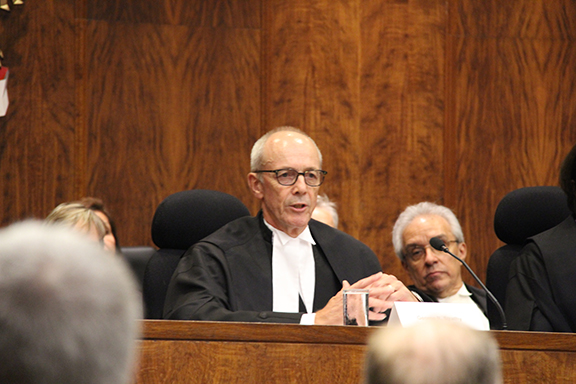
 Chief Justice George Strathy says the province’s justice sector needs “substantial investment” in order to bring it into the 21st Century.
Chief Justice George Strathy says the province’s justice sector needs “substantial investment” in order to bring it into the 21st Century.
As some of the province’s top judges and lawyers convened in downtown Toronto for the Opening of the Courts ceremony Tuesday, chief justices took the opportunity to call for the modernization of Ontario’s court system.
“We know that the bar would like to increase the efficiency and ease with which you can file materials electronically and to improve the convenience with which you can make remote appearances,” said Strathy, who serves as the Chief Justice of the Court of Appeal.
Chief Justice Heather Forster Smith, of the Ontario Superior Court, said modern court administration and courtrooms are needed in order to make the judicial system more efficient.
“We urgently need the technology that can expedite the administrative and important steps in all areas of the court’s work,” she said.
The provincial government expanded an e-filing pilot in the spring for the Small Claims Court, but critics have said this was a mere baby step in the provincial court’s overly cautious move away from the paper-based system.
Making the court more efficient through digitized systems is all the more pressing after the Supreme Court of Canada’s decision in R. v. Jordan, chief justices said.
The decision set strict timelines on the amount of time a trial could be delayed.
“If judges and registrars could access case management information in the courtroom, if judges could issue signed orders from the courtroom, if judges and the bar could access legal research with Wi-Fi from the courtroom, if reliable teleconferencing and video conferencing were available in at least principal courtrooms, if all of these tools were available to our judges across the province, I’m certain that we could generate efficiencies to consistently meet tighter deadlines,” Smith said.
In his remarks to the chamber, Attorney General Yasir Naqvi reaffirmed the provincial government’s commitment to further digitizing the courts.
E-filing for the Small Claims Court and other technological advances are “just the beginning,” he said.
“Each of these initiatives are working to make our justice system more accessible and user friendly. I’m confident that by continuing to collaborate, to share ideas and information, we will be able to continue modernizing the delivery of justice services in our province.”
The Ministry of the Attorney General has a modernization division, which is spearheading technological court advances, Smith said.
Strathy said the courts are also working in partnership with the Ministry of the Attorney General on reviewing technological innovation.
“I know the Attorney General and his staff at the ministry recognize this need and I express the hope that resources will be provided to address that,” he said.
Strathy also touched upon the urgent need for the province to tackle the disproportionate number of aboriginal people who are incarcerated, as well as expanding the Unified Family Court system.
The appeal court chief justice was optimistic that technological advances would be coming to the courts sooner rather than later.
“We are reviewing our options for technological improvement and we hope to make substantial changes in the coming years and I would say the near future,” Strathy said.